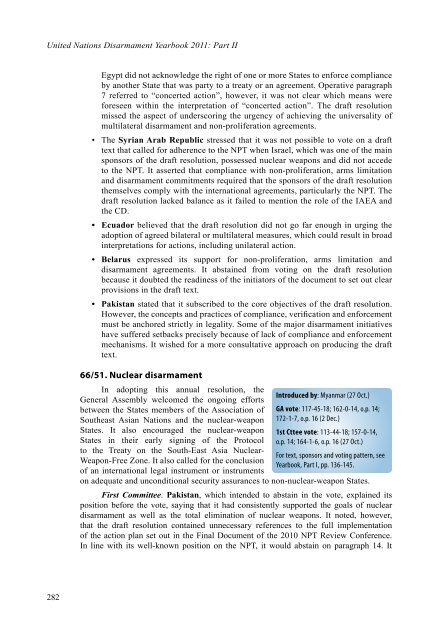DYB2011-Part-II-web
DYB2011-Part-II-web
DYB2011-Part-II-web
You also want an ePaper? Increase the reach of your titles
YUMPU automatically turns print PDFs into web optimized ePapers that Google loves.
United Nations Disarmament Yearbook 2011: <strong>Part</strong> <strong>II</strong><br />
282<br />
Egypt did not acknowledge the right of one or more States to enforce compliance<br />
by another State that was party to a treaty or an agreement. Operative paragraph<br />
7 referred to “concerted action”, however, it was not clear which means were<br />
foreseen within the interpretation of “concerted action”. The draft resolution<br />
missed the aspect of underscoring the urgency of achieving the universality of<br />
multilateral disarmament and non-proliferation agreements.<br />
• The Syrian Arab Republic stressed that it was not possible to vote on a draft<br />
text that called for adherence to the NPT when Israel, which was one of the main<br />
sponsors of the draft resolution, possessed nuclear weapons and did not accede<br />
to the NPT. It asserted that compliance with non-proliferation, arms limitation<br />
and disarmament commitments required that the sponsors of the draft resolution<br />
themselves comply with the international agreements, particularly the NPT. The<br />
draft resolution lacked balance as it failed to mention the role of the IAEA and<br />
the CD.<br />
• Ecuador believed that the draft resolution did not go far enough in urging the<br />
adoption of agreed bilateral or multilateral measures, which could result in broad<br />
interpretations for actions, including unilateral action.<br />
• Belarus expressed its support for non-proliferation, arms limitation and<br />
disarmament agreements. It abstained from voting on the draft resolution<br />
because it doubted the readiness of the initiators of the document to set out clear<br />
provisions in the draft text.<br />
• Pakistan stated that it subscribed to the core objectives of the draft resolution.<br />
However, the concepts and practices of compliance, verification and enforcement<br />
must be anchored strictly in legality. Some of the major disarmament initiatives<br />
have suffered setbacks precisely because of lack of compliance and enforcement<br />
mechanisms. It wished for a more consultative approach on producing the draft<br />
text.<br />
66/51. Nuclear disarmament<br />
In adopting this annual resolution, the<br />
Introduced by: Myanmar (27 Oct.)<br />
General Assembly welcomed the ongoing efforts<br />
between the States members of the Association of GA vote: 117-45-18; 162-0-14, o.p. 14;<br />
Southeast Asian Nations and the nuclear-weapon 172-1-7, o.p. 16 (2 Dec.)<br />
States. It also encouraged the nuclear-weapon 1st Cttee vote: 113-44-18; 157-0-14,<br />
States in their early signing of the Protocol o.p. 14; 164-1-6, o.p. 16 (27 Oct.)<br />
to the Treaty on the South-East Asia Nuclear-<br />
For text, sponsors and voting pattern, see<br />
Weapon-Free Zone. It also called for the conclusion<br />
Yearbook, <strong>Part</strong> I, pp. 136-145.<br />
of an international legal instrument or instruments<br />
on adequate and unconditional security assurances to non-nuclear-weapon States.<br />
First Committee. Pakistan, which intended to abstain in the vote, explained its<br />
position before the vote, saying that it had consistently supported the goals of nuclear<br />
disarmament as well as the total elimination of nuclear weapons. It noted, however,<br />
that the draft resolution contained unnecessary references to the full implementation<br />
of the action plan set out in the Final Document of the 2010 NPT Review Conference.<br />
In line with its well-known position on the NPT, it would abstain on paragraph 14. It


